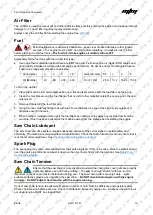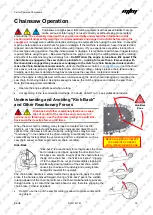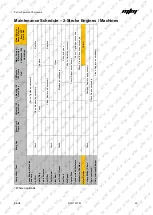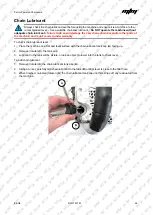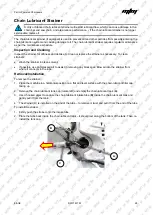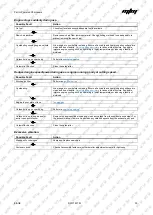
Petrol Powered Chainsaws
E&OE
©2017 MTM
29
Engine Tuning Guidelines
Running combustion engines in confined areas
CAN KILL IN MINUTES
. Engine exhaust
fumes contain carbon-monoxide
– a deadly gas that you cannot smell or see. NEVER run
a combustion engine in confined areas EVEN IF windows and doors are open. ONLY run
combustion engines OUTDOORS and away from doors, windows and vents. • Petrol / fuel
/ gasoline is extremely flammable
– keep clear of naked flames or other ignition sources. •
Do not
have the engine running during inspection and maintenance unless specifically required. • The engine
should be cool enough to touch before perfo
rming maintenance activities. • Some maintenance activities
may be beyond the scope of some users. Do NOT attempt procedures that you are not comfortable with, or
do not have the necessary tools, experience or knowledge for
– take the unit to an authorised service centre
or qualified technician for servicing. •
Failure to follow the maintenance schedule, using incorrect or
non-compatible accessories or replacements parts, or general negligence
may result in making the
product warranty void
. • Improper tuning can lead to engine failure –
engine failure due to improper
tuning is not covered under warranty
. • If you cannot tune the engine, contact an authorised service
centre for assistance or have the machine checked by a small engine special
ist. • The carburettor is supplied
factory-set and should run properly. Engine tuning should be attempted only if the machine shows signs of
requiring adjustment. • A tachometer is recommended for setting engine idle and full throttle speeds.
The engine must be maintained in a reasonable "state of tune" to ensure best performance and safety. If the
engine is running roughly, emitting excessive smoke, not revving properly, not idling properly, showing signs
of reduced power, not responding crisply to the throttle etc, it may require "tuning". Basic tuning for 2-stroke
engines is not difficult, however, care should be taken in understanding the tuning process and learning how
to recognise the symptoms for when engine tuning is required and where and how to make adjustments.
Note that factors such as altitude, fuel mixture, ambient temperature etc may all affect engine running
characteristics. There are two basic engine conditions that determine improper tune:
•
Rich
- An adjustment that is too rich will cause the engine to smoke, have insufficient power, result in
additional carbon build up and may damage the engine. The proportion of fuel in the air/fuel mixture is so
high that the fuel does not burn well. The partially burned mixture is expelled into the exhaust and exits
the engine as smoke. Carbon build-up may affect the performance of the spark arrestor (if equipped) and
cylinder ports if run for a period of time. Outside of carburettor adjustments this can also be caused by
having too much oil mixed with the fuel, and/or old fuel.
•
Lean
- An adjustment that is too lean will also cause the engine to have insufficient power and is more
likely to damage the engine than a rich mixture. The proportion of fuel in the air/fuel mixture is so low that
there is not enough fuel to burn. Lean running causes the cylinder temperature to rise, which often leads
to engine seizure, and for excessive revving which may result in connecting rod bearing failure. Other
causes for a lean running condition include lack of oil in the fuel mix, and when the fuel tank runs empty.
Before any engine tuning:
•
Service the
•
Service the
•
Use fresh
Carburettor Adjustments
The engine carburettor has 3 adjustments available:
•
Idle Speed
– Controls how open the throttle is when the throttle trigger is released. If idle speed is set
too low, the engine will stop when the throttle is released due to a lack of air/fuel mixture. If idle speed is
set too high, the engine will run when the throttle is released, however, at a speed that will engage the
clutch and cause the saw chain to rotate
– this is a dangerous condition that should never be allowed.
•
Low Speed Mixture
– Controls the proportion of fuel in the air/fuel mixture at idle speed. If the low
speed mixture is too rich, the engine will load up when idling and then stop. If the low speed mixture is
too lean, the engine will race or surge when idling and then stop.
•
High Speed Mixture
– Controls the proportion of fuel in the air/fuel mixture at cutting speed. If the high
speed mixture is too rich, the engine may not reach the speed necessary for maximum power, emit
excessive smoke and respond poorly to throttle movement. If the high speed mixture is too lean, the
engine maty reach speeds where bearing failure and cylinder seizure are likely. It will also lack power
and tend to run very hot.
MTM MTM MTM MTM MTM MTM MTM MTM MTM MTM MTM MTM MTM MTM MTM MTM MTM MTM MTM MTM MTM MTM MTM MTM
MTM MTM MTM MTM MTM MTM MTM MTM MTM MTM MTM MTM MTM MTM MTM MTM MTM MTM MTM MTM MTM MTM MTM MTM
MTM MTM MTM MTM MTM MTM MTM MTM MTM MTM MTM MTM MTM MTM MTM MTM MTM MTM MTM MTM MTM MTM MTM MTM
MTM MTM MTM MTM MTM MTM MTM MTM MTM MTM MTM MTM MTM MTM MTM MTM MTM MTM MTM MTM MTM MTM MTM MTM
MTM MTM MTM MTM MTM MTM MTM MTM MTM MTM MTM MTM MTM MTM MTM MTM MTM MTM MTM MTM MTM MTM MTM MTM
MTM MTM MTM MTM MTM MTM MTM MTM MTM MTM MTM MTM MTM MTM MTM MTM MTM MTM MTM MTM MTM MTM MTM MTM
MTM MTM MTM MTM MTM MTM MTM MTM MTM MTM MTM MTM MTM MTM MTM MTM MTM MTM MTM MTM MTM MTM MTM MTM
MTM MTM MTM MTM MTM MTM MTM MTM MTM MTM MTM MTM MTM MTM MTM MTM MTM MTM MTM MTM MTM MTM MTM MTM
MTM MTM MTM MTM MTM MTM MTM MTM MTM MTM MTM MTM MTM MTM MTM MTM MTM MTM MTM MTM MTM MTM MTM MTM
MTM MTM MTM MTM MTM MTM MTM MTM MTM MTM MTM MTM MTM MTM MTM MTM MTM MTM MTM MTM MTM MTM MTM MTM
MTM MTM MTM MTM MTM MTM MTM MTM MTM MTM MTM MTM MTM MTM MTM MTM MTM MTM MTM MTM MTM MTM MTM MTM
MTM MTM MTM MTM MTM MTM MTM MTM MTM MTM MTM MTM MTM MTM MTM MTM MTM MTM MTM MTM MTM MTM MTM MTM
MTM MTM MTM MTM MTM MTM MTM MTM MTM MTM MTM MTM MTM MTM MTM MTM MTM MTM MTM MTM MTM MTM MTM MTM
MTM MTM MTM MTM MTM MTM MTM MTM MTM MTM MTM MTM MTM MTM MTM MTM MTM MTM MTM MTM MTM MTM MTM MTM
MTM MTM MTM MTM MTM MTM MTM MTM MTM MTM MTM MTM MTM MTM MTM MTM MTM MTM MTM MTM MTM MTM MTM MTM
MTM MTM MTM MTM MTM MTM MTM MTM MTM MTM MTM MTM MTM MTM MTM MTM MTM MTM MTM MTM MTM MTM MTM MTM
MTM MTM MTM MTM MTM MTM MTM MTM MTM MTM MTM MTM MTM MTM MTM MTM MTM MTM MTM MTM MTM MTM MTM MTM
MTM MTM MTM MTM MTM MTM MTM MTM MTM MTM MTM MTM MTM MTM MTM MTM MTM MTM MTM MTM MTM MTM MTM MTM
MTM MTM MTM MTM MTM MTM MTM MTM MTM MTM MTM MTM MTM MTM MTM MTM MTM MTM MTM MTM MTM MTM MTM MTM
MTM MTM MTM MTM MTM MTM MTM MTM MTM MTM MTM MTM MTM MTM MTM MTM MTM MTM MTM MTM MTM MTM MTM MTM
MTM MTM MTM MTM MTM MTM MTM MTM MTM MTM MTM MTM MTM MTM MTM MTM MTM MTM MTM MTM MTM MTM MTM MTM
MTM MTM MTM MTM MTM MTM MTM MTM MTM MTM MTM MTM MTM MTM MTM MTM MTM MTM MTM MTM MTM MTM MTM MTM
MTM MTM MTM MTM MTM MTM MTM MTM MTM MTM MTM MTM MTM MTM MTM MTM MTM MTM MTM MTM MTM MTM MTM MTM
MTM MTM MTM MTM MTM MTM MTM MTM MTM MTM MTM MTM MTM MTM MTM MTM MTM MTM MTM MTM MTM MTM MTM MTM
MTM MTM MTM MTM MTM MTM MTM MTM MTM MTM MTM MTM MTM MTM MTM MTM MTM MTM MTM MTM MTM MTM MTM MTM
MTM MTM MTM MTM MTM MTM MTM MTM MTM MTM MTM MTM MTM MTM MTM MTM MTM MTM MTM MTM MTM MTM MTM MTM

